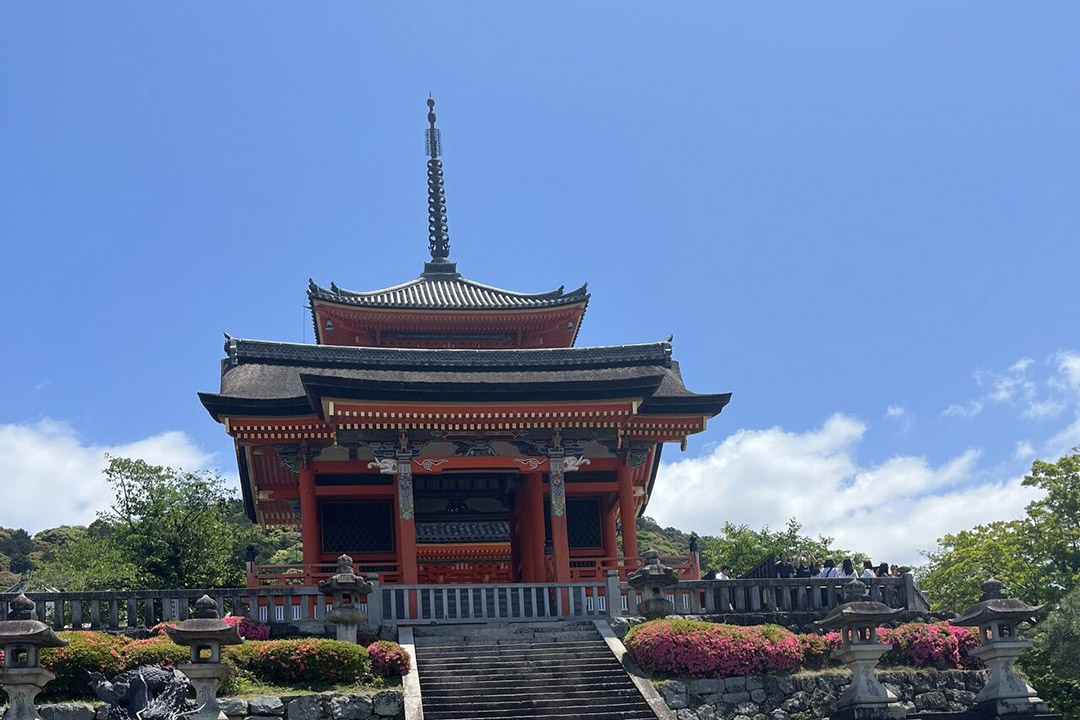Travel-enhanced game design and development course takes students to Japan
Trip and game jam immerses students in Japanese video game industry and culture
Fourteen RIT students completed a two-week study abroad this summer, where they explored Japanese history, the Japanese video game industry, and culture, including the Kiyomizudera Temple (pictured).
Sofia Orlando has wanted to visit Japan since middle school. This summer, the second-year new media design student, got to explore three Japanese cities as part of a travel-enhanced RIT class.
The two-week trip was the culmination of the Japanese Game Industry course, where students learned about the world’s third largest video game market. RIT students immersed themselves in the culture, participated in a game jam with Japanese students, and visited a major Japanese game studio.
The 14 RIT students came from a range of disciplines, including 3D digital design, computer science, game design and development, new media design, film and animation, and illustration. Several students are also pursuing the Japanese modern language and culture minor (five courses) and immersion (three courses).
Provided
At the game jam, Sofia Orlando, center back, came together with teammates to develop a game that has players destroy their house to find and pet a cat.
The trip went through the Japanese cities of Tokyo, Kyoto, Hiroshima, and Osaka. Students toured the Japanese video game development studio CyberConnect2, known for its games based on the Naruto and .hack franchises, among others.
During the first week, RIT students visited the Kyoto Computer Gakuin (KCG) to collaborate with Japanese students who are in the school’s digital games and amusements programs. For one weekend, the students teamed up for a game jam to create video games from scratch around the theme of simple things that they enjoy.
“All the students on my team contributed and discussed ideas for the game and we eventually landed on Doko Neko Hakai, a game about destroying your house to find your cat and pet her after a long day,” said Orlando, who is from Hoboken, N.J. “My team was nothing but kind, friendly, and patient. I had so much fun working with them, and I hope to remain friends for a very long time. I can’t wait to return to Japan soon.”
Isabella Frohlich, a fourth-year game design and development major from Manhattan, also reflected on her game jam in a blog post online.
“While it certainly posed some unique challenges—such as finding a way to clearly express our ideas through the language barrier—it was an incredible learning experience, providing us with new perspectives, connections, and solutions,” wrote Frohlich. “Whether it be the serene shrines in Kyoto, or the bustling streets of Shibuya, every step of the trip was packed with sights that I’ll always hold in my heart.”
In addition to video game-related visits, the RIT group took time to experience the history and culture of Japan, making stops at the Fushimi Inari Shrine, Arashiyama Bamboo Forest, and Kinkaku-ji Golden Pavilion Zen Buddhist Temple. They also visited the Yayoi Kusama Museum, Hiroshima Peace Memorial Museum, and the teamLab Planets immersive art museum.
Stephen Jacobs, a professor in RIT’s School of Interactive Games and Media (IGM), has taught study abroad courses on the Japanese video game industries three times before. The course will be offered again in spring 2025 with a trip in May. He chose to create a study abroad to Japan because of the country’s key role in the video game industry. This course was also led by IGM lecturer Sten McKinzie.
“For some students, this course gives a real-world look at where their skills can take them—such as a game studio and immersive entertainment,” said Jacobs. “For all of the students in the class, regardless of their major, it’s a face-to-face opportunity to design and create with peers in another country. They also get to experience the culture and history of a place they’re fascinated with.”
Kofi Bazzell-Smith, a future faculty fellow in RIT’s College of Art and Design, also went on the trip. He is developing another travel-enhanced RIT course for next summer on Introduction to Manga. Illustration students will get to learn about the storytelling structure and drawing techniques of Japanese manga. Students will complete the course by creating their own one-shot manga.
“The impact of Japanese media, anime, manga, video games, and J-pop on the West has been so significant since the 1990s,” said Bazzell-Smith. “I think students will really enjoy this because it will be the first course like this offered in the U.S.”
RIT offers some of the world’s best programs for aspiring game developers in the world, according to international rankings from The Princeton Review.











